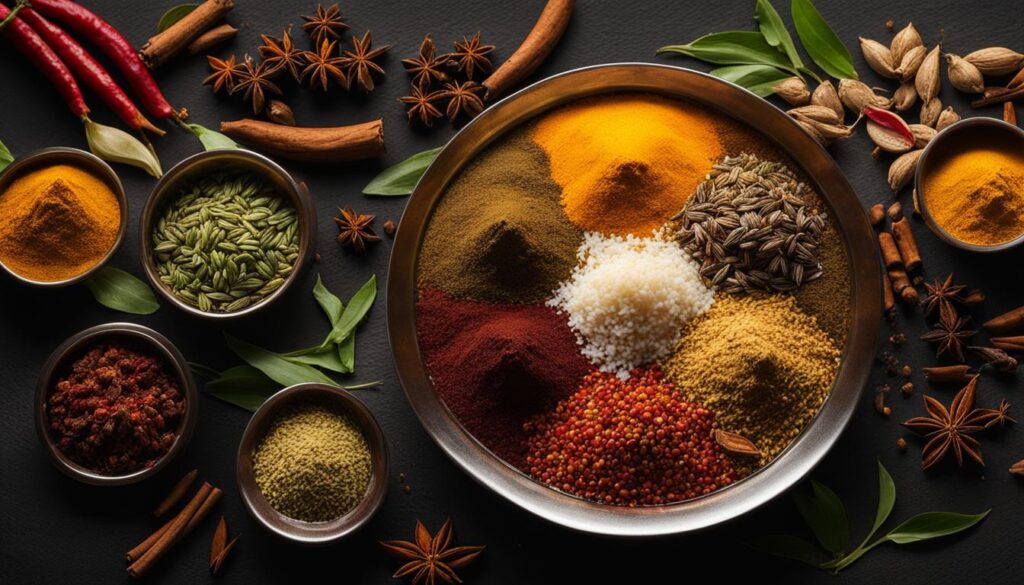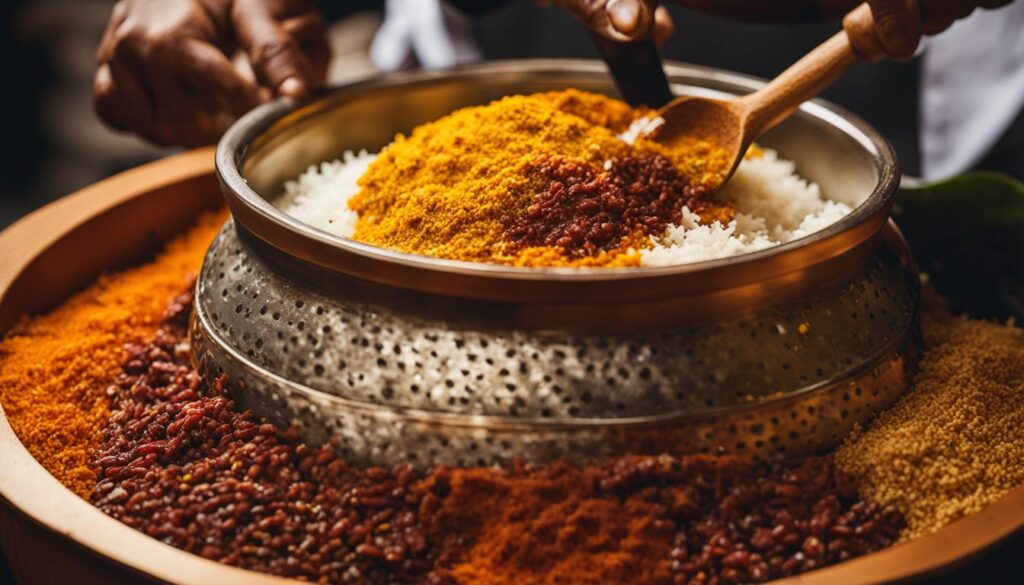The quest to master the art of the perfect biryani is one that takes patience, passion, and a deep understanding of the symphony played by spice mixtures on one’s palate. As a food enthusiast residing in the United Kingdom, I’ve come to appreciate the intricate dance of biryani spices that characterises this beloved dish. Within its layers, the harmonious blend of authentic biryani flavours reveals the mosaic of traditional spice mix and the wealth of Indian spices. Through my culinary explorations, I’ve observed that the right balance of rich spices and flavorful seasonings is crucial to elevate one’s cooking game.
Whether I’m sautéing whole cinnamon sticks, toasting cardamom pods, or stirring in cloves to a bubbling pot, I understand that each element plays a pivotal role in the final result. Let’s journey together through the bewildering yet fascinating world of biryani spices, where I’ll help illuminate the path to creating an immaculate biryani right in the comforts of your kitchen.
Key Takeaways
- Master an array of biryani spices for that signature aromatic punch.
- Delve into the diversity of authentic biryani flavours that make every bite memorable.
- Learn the craft of mixing traditional spice mix for a genuine biryani experience.
- Understand the key role of Indian spices in achieving that depth of flavour.
- Familiarise yourself with the use of rich spices, perfect for creating a sumptuous dish.
- Discover how to apply flavorful seasonings for a sublime gastronomic pleasure.
Essential Biryani Spices for an Authentic Flavour Experience
When I think of the dishes that truly encapsulate the spirit of Indian cuisine, biryani invariably springs to my mind. It’s a dish that is so much more than its components; it’s the essence of a cultural journey, brought to life through a melange of essential biryani spices. As a passionate cook, I’ve found that the key to a memorable biryani lies indisputably in its spice assortment. Today, I’ll share with you the traditional spices that are, in my opinion, non-negotiable for authentic Indian biryani.
Coriander seeds, with their citrusy charm, and fenugreek, emanating subtle yet complex bitterness, lay the foundation of our spice mélange. We elevate this base with a touch of warm, sweet nutmeg — a spice revered across cuisines for the depth it offers. However, no traditional spice mix could ever be complete without the inclusion of handpicked aromatic Indian spices like cinnamon, black pepper, black and green cardamom, cloves, and of course, the fiery chilies.
Symbolic of India’s rich spice heritage, these aromatic spices are toasted to perfection and ground to unleash their oils, the lifeblood of their fragrance and flavour. This intricate process is not just about following a recipe; it’s akin to an artist mixing their paints to get the perfect hue for their canvas — in this case, our canvas is rice interlaced with succulent pieces of chicken. The alchemy of these spices, when unified, result in a palate that’s sumptuous, having a gastronomic resonance that’s nothing short of indulgent.
| Spice | Aroma Profile | Flavour Notes |
|---|---|---|
| Coriander Seeds | Citrusy, Woody | Earthy, with a hint of sweetness |
| Fenugreek | Bitter, Sharp | Slightly sweet, nutty aftertaste |
| Nutmeg | Warm, Nutty | Rich, Subtle woody sweetness |
| Cinnamon | Sweet, Woody | Spicy and warm with a delicate sharpness |
| Black Pepper | Sharp, Peninsula | Pungent with an earthy, woody taste |
| Cardamom (Green & Black) | Complex, Resinous | Sweet and spicy with a cool menthol undertone |
| Cloves | Floral, Rich | Pungently sweet with a fierce heat |
| Chilies | Pungent, Penetrating | Intense heat followed by a subtle, fruity sweetness |
Mastering the blend of these essential biryani spices is a craft, a token of devotion to the culinary arts, that promises a transcendence in every bite. Should you venture to create this esteemed dish, take a moment to appreciate the spice assortment that has travelled through time to reach your kitchen, and with it, bring forth a flavour experience that resonates with centuries of tradition.
Mastering the Art of Spice Blending
As an ardent cook and biryani aficionado, I’ve come to realise that crafting the perfect biryani is much like painting with flavours; a dash too many of an aromatic spice or an imbalanced spice blend can distinguish between culinary delight and disarray. Let me guide you through the intricate steps to ensure your biryani spices strike the perfect chord for a symphony of flavours.
Identifying the Right Proportions
Achieving the correct balance in your spice blend is crucial. The combination of fragrant spices—each with their unique profiles—should complement rather than compete with one another. Through trial and refinement, I have found that attentiveness to proportions is what differentiates a good biryani from an unforgettable one. Below is a table that I rely on for measuring out each spice, ensuring a harmonious blend every time.
| Spice | Amount for 500g Chicken | Flavour Note |
|---|---|---|
| Cumin Seeds | 1 tsp | Earthy |
| Coriander Powder | 2 tsp | Woody and Floral |
| Turmeric | 1/2 tsp | Earthy and Bitter |
| Red Chilli Powder | 1 tsp | Fiery |
| Garam Masala | 1 tsp | Warm and Complex |
| Biryani Spices Mix | 2 tbsp | Rich and Intense |
Combining Whole and Ground Spices
Marrying whole and ground spices is the secret to a layered depth of flavours. My approach begins by gently toasting whole spices to unlock their essential oils, before grinding select pieces to enhance the pungency. The dual textures, one providing bursts of aroma in between mouthfuls and the other enveloping the dish in a delicate spice veil, are pivotal for the multidimensional experience of biryani.
The Role of Marination in Enhancing Spice Flavours
Marination is the transformative process where the porous chicken pieces absorb the flavorful seasonings. During this crucial time of rest, the varied nuances of biryani spices merge, tenderising the protein and imparting a sultry allure to the eventual dish. My top tip is to marinate overnight, thus allowing every element of the spice mix to contribute to the rich, heady scent and profound taste of the final plateful.
Commit these stages to practice, and with each attempt, the alchemy of spices and seasonings will become less of an elusive quest and more of an intimate dance you lead with confidence, ensuring each batch of biryani you prepare is steeped in tradition and brimming with gastronomic excellence.
Biryani Spices

Embarking on the pursuit of the quintessential biryani, I find that the heart of its creation lies within the symphony of Indian spices. Every cookout transforms into an exploration when you have an array of authentic biryani flavors at your fingertips. Each spice, a vibrant thread in the rich tapestry of traditional Indian cookery, contributes to a truly majestic spice blend. Today, I am sharing with you the allure of these spices, which combine to form the most traditional spice mix that elevates a simple dish into the beloved biryani.
| Spice | Character | Role in Biryani |
|---|---|---|
| Kashmiri Chili Powder | Vibrant Colour, Mild Heat | Provides the signature red hue without excessive heat. |
| Turmeric | Earthy, Peppery | Imparts a rich golden-yellow tint and adds antioxidant properties. |
| Garam Masala | Warm, Aromatic | A blend within a blend, rounding up flavors with its complex warmth. |
The marination stage stands at the center of biryani’s flavour building process. This allows for the perfect mingling of spices, permeating the succulence of the chicken with deep, penetrating biryani spices. The traditional marination palette often includes fresh herbs like cilantro and mint, alongside a base of yogurt, lemon, and the zing of garlic and ginger paste. This is not just about food; it’s an act of alchemy where each ingredient echoes its essence within the dish.
Close your eyes and imagine these spices unifying into one masterpiece. The method is simple yet sacred, just like traditional practices handed down through generations.
Reflecting upon the bliss that authentic biryani spells on the palate, it is the magic of these spices and the passion inherent in their use which crafts the celebration on the plate. It’s a harmonious feast, a banquet of the senses, where each component of the spice mix cascades its presence into a perfect balance, much like the artists painting with the most vibrant colors gifted by nature.
Layering Techniques and Cooking Methods to Infuse Flavour

As I delve into the world of biryani preparation, I appreciate the sophistication of layering techniques and cooking methods that elevate this dish from simply seasoned rice to a culinary marvel. It’s about constructing flavour upon flavour, using an array of flavorful seasonings and biryani spices to achieve that signature blend that biryani aficionados adore. Let me walk you through the nuances of this process.
The Sequential Layering of Biryani
The essence of a splendid biryani lies in its layering. Ideally, the process involves the alternate stacking of spiced chicken and partially cooked basmati rice, but it’s the intricacy of the sequence that ensures the uniform distribution of the spice assortment throughout the dish. The entire affair is akin to painting, with each layer adding a stroke of colour and depth to the masterpiece that biryani is.
Dum Cooking: Sealing In the Aroma and Taste
Central to infusing biryani with its distinctive aromas is dum cooking. This age-old practice involves sealing the pot, usually with a layer of kneaded flour, and cooking the biryani on a low flame. This method not only protects the precious aromas but also allows for them to circulate and permeate each grain of rice, infusing it with the complex essence of our carefully selected biryani spices.
Adjusting Heat Levels for Perfect Cooking
Managing the heat at which biryani cooks is not merely a matter of preventing a burnt bottom layer. The right temperature is what teases out the intricacies of each spice, marrying them under the gentle, consistent steam that transforms the ingredients into an aromatic delight. Below is a breakdown of the heat regulation process:
| Stage | Heat Level | Duration | Purpose |
|---|---|---|---|
| Initial Cooking | High | 5 minutes | Sealing in juices |
| Dum Phase 1 | Medium | 20 minutes | Developing flavours |
| Dum Phase 2 | Low | 30 minutes | Intensifying aroma |
| Resting Time | Off | 10 minutes | Allowing flavours to settle |
In mastering the complexities of layering techniques, dum cooking, and heat control, one garners not just the skills to cook biryani but an insight into the heart of culinary craftsmanship.
Conclusion
In my pursuit of the ultimate biryani, I’ve traipsed through a kaleidoscope of aromatic spices, each more fragrant and enticing than the last. It has been a revelation, discovering how traditional cooking techniques like dum cooking can act as a canvas for the rich spices and flavorful seasonings that serve as the pillars of authentic biryani flavors. The right spice blend, I’ve learned, is the heartbeat of this storied dish, pulsating through every mouthful with a promise of gastronomic delight.
From meticulously handpicked Indian spices to the ritualistic marination that ensnares the senses, biryani is a testament to the power of patience and precision. Each layer, lovingly adorned, speaks volumes of the respect afforded to the age-old traditions that dictate biryani’s creation. Every succulent piece of chicken, bathed in a gala of premium chicken biryani masala, mirrors the depth of commitment to the craft.
The tapestry of traditional spice mix intertwined with humble rice and meat is nothing short of culinary magic. It transforms a simple meal into a celebration of flavours and aromas that resonate with the tales of its rich heritage. Creating this iconic dish has been less of a task and more of a transformative journey—a true voyage into the heart of Indian cuisine. As I stand back, admiring the fruits of my labour, I find myself humbly reminded that biryani is more than a dish; it’s a narrative of culture, a symphony of spices, each note carefully composed to sing in perfect harmony.
FAQ
What are the essential biryani spices for an authentic flavour experience?
Biryani’s authentic flavour experience is derived from a blend of essential biryani spices, which typically include cinnamon, green and black cardamom, cloves, coriander seeds, cumin seeds, bay leaves, nutmeg, mace, and star anise, among others. It’s the balance of these aromatic spices that gives biryani its unique and deep flavour profile.
How can I identify the right proportions of biryani spices for my dish?
Identifying the right proportions involves both practice and personal taste. A good starting point is to follow a traditional recipe and adjust according to your preference. Remember, the key is to achieve a balanced blend where no single spice overpowers the others.
Should I use whole or ground spices for biryani?
Both have their place in biryani cooking. Whole spices are typically used for infusing the oil and releasing their aroma at the beginning of cooking, while ground spices can be mixed with yogurt in the marination process to ensure the flavour permeates the chicken or other main ingredients. Combining both yields a more complex flavour.
How does marination enhance the flavour of biryani spices?
Marination acts as a vessel for the biryani spices to tenderize and flavour the protein, typically chicken. By letting the meat marinate in spices, yogurt, and other seasonings, you allow the spices to penetrate deeply, resulting in a more flavourful and tender final dish.
What is the sequential layering technique in biryani?
Sequential layering in biryani involves arranging layers of marinated meat and partially cooked basmati rice in a pot. Usually, you start with a layer of meat, then rice, and repeat, ensuring there’s an equitable distribution of spices and flavours throughout the biryani.
What is the importance of dum cooking in making biryani?
Dum cooking is a traditional Indian cooking technique where food is slowly cooked in a sealed container. This method traps the steam and cooks the biryani in a manner that allows the spices to fully infuse the dish with their flavours, resulting in a rich and aromatic finish.
How do I adjust heat levels when cooking biryani?
Controlling the heat is critical when cooking biryani. Start with a high heat to develop flavours and then lower it to allow the dish to simmer gently. This slow-cooking process helps in retaining the delicate flavours of the spices while ensuring that the rice and meat are perfectly cooked.

